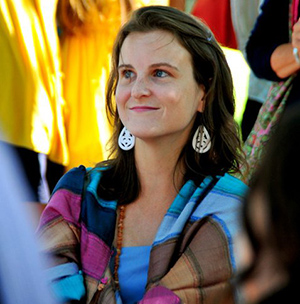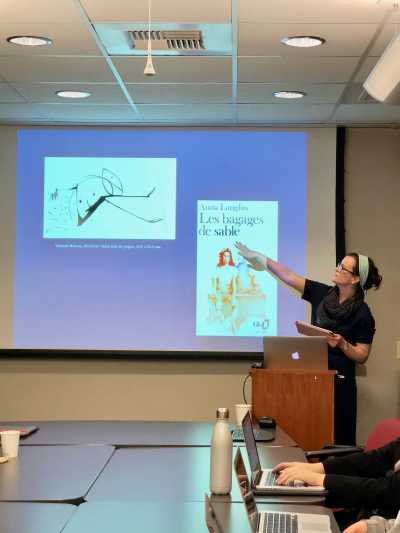Kathryn Brackney Lecture Summary

"Phantom Geographies in Representations of the Holocaust"
Kathryn Brackney (PhD Candidate, Yale University)
2017-2018 Katz Research Fellow in Genocide Studies
March 22, 2018

Kathryn Brackney, the 2017-2018 Katz Research Fellow in Genocide Studies, gave a public lecture on the research she conducted during her month in residence at the Center. During her residency Brackney explored the Visual History Archive looking for “otherworldliness” in the testimonies -- moments in which Holocaust survivors describe their experiences as belonging to another world or another dimension. For her dissertation research, Brackney has already consulted other kinds of sources, such as literature and philosophy, to explore the presence of “otherworldliness” in survivors’ narratives. Her residency at the Center provided the opportunity to include survivors’ testimonies in her work and examine whether the kind of figurative and abstract language she has found in other sources emerges in these testimonies as well.
Brackney began her lecture by reflecting on a famous event that happened during the Eichmann trial in 1961, which eventually sparked her interest in the topic of otherworldliness. Yehiel De-Nur, a survivor who spent two years in Auschwitz, testified during the trial. In his testimony, De-Nur referred to Auschwitz as “planet Auschwitz,” said Brackney, and after he was asked to speak in a non-symbolic language, De-Nur collapsed and was taken away from the court. Brackney continued by mentioning instances in which other Holocaust survivors used highly symbolic language when describing their experiences of the Holocaust. As an example, Brackney mentioned Avrom Sutzkever, a famous Yiddish poet, who also used abstract language in his poetry written in the Vilna ghetto, but also in his poems written after the war. Brackney noted that, in the first two decades after the war, many survivors described themselves as being “washed ashore.”
Brackney explained that when navigating the Visual History Archive, she started her search by watching interviews by survivors who wrote poetry or displayed artwork since she expected to find them using symbolic language. As she expanded her search beyond artists, she was surprised by the frequency of this kind of language in the testimonies. She found it most often when survivors speak about their emigration experiences, liberation, and similar moments of movement, change, or transition.
Brackney then laid out the three main categories of experiences survivors are talking about most often when they employ symbolic language or evoke images of otherworldliness: 1) in the camp/beyond the camp; 2) burial spaces and images of afterlife, and; 3) postwar difference. While she briefly elaborated on the first two categories, Brackney particularly focused her presentation on the third category of postwar difference. In this regard, Brackney argued that survivors often talked about their liberation as a transition into a new world. Survivors conceived of themselves as being alien and not belonging, and feeling like they were from another planet.
Brackney noted that many survivors talked about how the Holocaust changed them both emotionally and physically, and provided an example of a female survivor who, due to her inability to bear the smell of Auschwitz, consequently completely lost her sense of smell. Brackney played a short excerpt from the testimony of Donia Clenman to illustrate these points. In her testimony, Clenman articulates how she felt disciplined to stay in her new, alien identity as an emigre in Canada, how different she is from her Canadian children, and how she inhabits two different worlds at the same time.
After her elaboration on the category of postwar difference, Brackney turned her attention to a fourth category that she only discovered while watching the VHA testimonies. This category, which Brackney termed “transformation through storytelling and revisitations,” focuses on the ways the survivors describe how the act of revisiting the past and telling their story caused their emotional, and even in some cases, bodily transformation. For this purpose, Brackney chose three moving excerpts from the testimonies of Eddie Wynschenk, Max Garcia, and Edith Eger. Wynschenk narrated how his experience of revisiting and speaking about his past after years of avoiding to do so transformed not only himself, but also changed his relationship with his immediate family. Wynschenk recalled how speaking about his past caused him physical pain, and how his experience distanced him from his family. Garcia, on the other hand, recalled his visit to Auschwitz after the war as being surreal, and how he himself was not able to relate to his past. For Garcia, it became unreal that those horrors actually happened to him, and, as he stated in his testimony, he became a sort of a doubter himself. Finally, Eger’s testimony demonstrated her shift in identity – from victim to survivor – and how this shift resulted in an embodied transformation: the Nazis were no longer in her body, she stated.
In her analysis of these testimony excerpts, Brackney emphasized how the act of revisiting the past –through visits to particular places and/or through stories they tell about the past – makes survivors experience transformation. Amongst all the sources she consults in her research, the discovery of this transformation through storytelling and revisitation appears to be unique to the testimonies so far. She plans to conduct further research to see whether it appears in other types of sources.
In the final part of her talk, Brackney contextualized the importance of considering time when analyzing changes in language that survivors use when talking about their experiences. She argued that some of the changes she has delineated are due to shifts over time that affected the way survivors were perceived and represented. In this regard, she noted that during the 1960s, survivors were not yet humanized, and the theme of alienation was still frequent during this period. However, survivors started increasingly sharing their stories during the 1980s, which had a humanizing effect. Finally, Brackney concluded that the testimonies themselves assist survivors in negotiating their feelings of alienation.
The Q&A session included discussion of whether the physical transformations she mentioned are due to medical or psychological conditions; whether “playing” multiple characters is unique to survivors or something we all do; whether levels of abstraction differ by language; the question about the existence of any specific metaphor that Brackney was able to detect across her sources; the transnational movement of metaphors; whether the occurrence of alienating language is due to the limits of vocabulary; and the changes and differences in storytelling over time.
Summary by Badema Pitic
Like this article? Get our e-newsletter.
Be the first to learn about new articles and personal stories like the one you've just read.